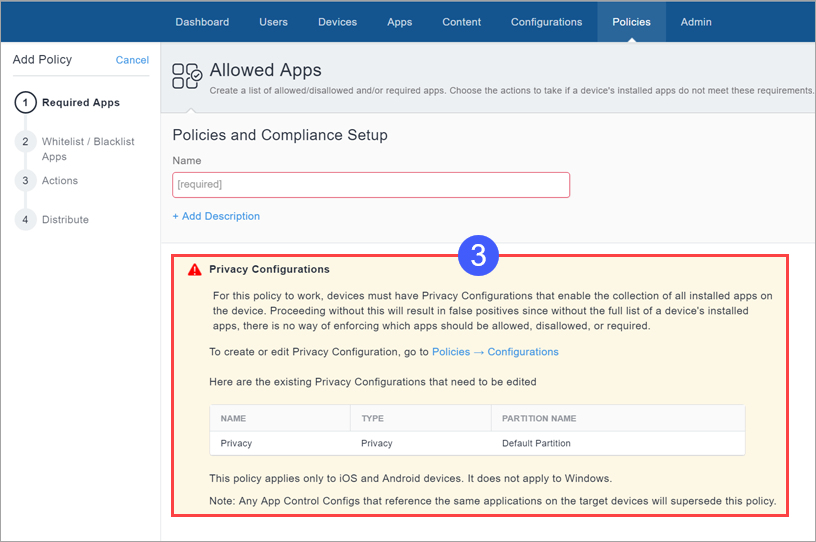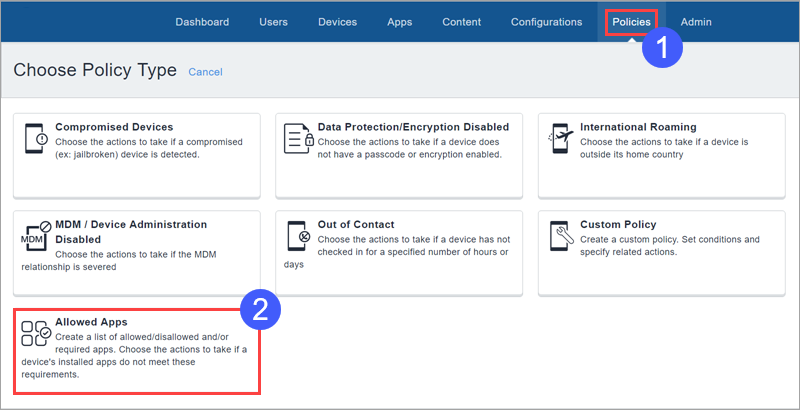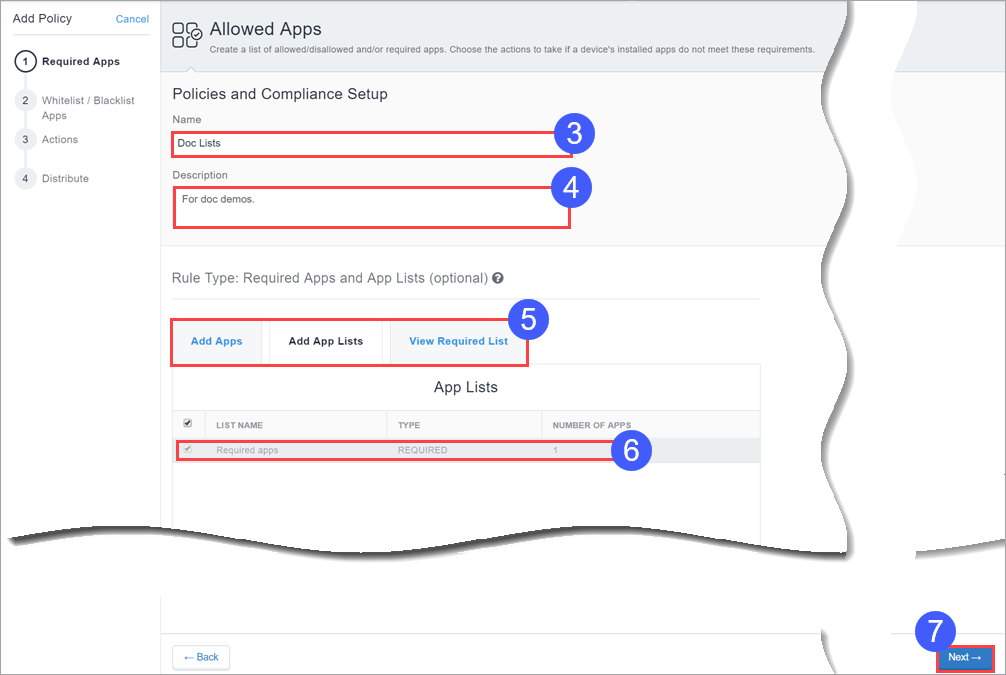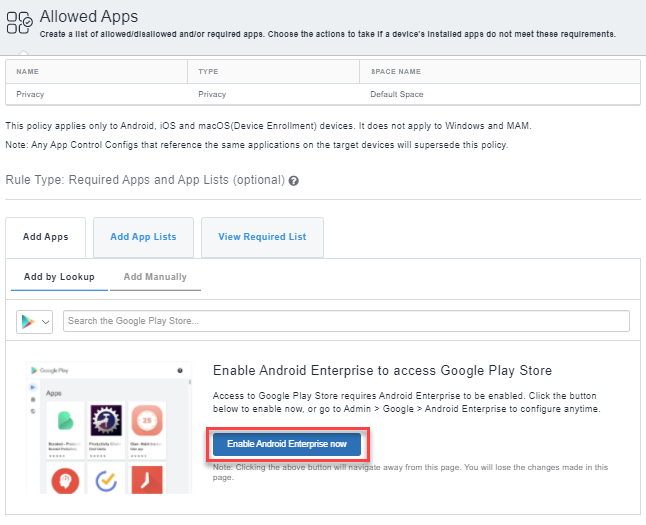Monitoring and Controlling Allowed Apps
License: Silver
To control which apps are installed on devices, you create an Allowed Apps policy. This policy also supports MobileIron Packager (MIP) in-house macOS apps. The policy contains the following information:
- Allowlist apps
 applications that are allowed on a device. A device that has other apps installed is considered out of compliance.
applications that are allowed on a device. A device that has other apps installed is considered out of compliance.
- Blockedlist apps
 applications that are not approved for installation on a device. A device that has any of these apps installed is considered out of compliance.
applications that are not approved for installation on a device. A device that has any of these apps installed is considered out of compliance.
- required apps
 applications that must be installed on a device. A device that is missing any of these apps is considered out of compliance.
applications that must be installed on a device. A device that is missing any of these apps is considered out of compliance.
- compliance actions
 automated responses to a device that violates rules for managed devices.
automated responses to a device that violates rules for managed devices.
If an app is both required and Blockedlisted, then the evaluation of the app against the required list takes precedence. For example, if an app A1 is present in both in the required list and the Blockedlist, then the apps policy evaluation for this device behaves as follows:
- Device will be compliant if A1 is installed on the device.
- Device will be non-compliant if A1 is not installed on the device.
Supported Devices
- Android 4.2 or supported newer versions
- iOS 8.0 or supported newer versions
- macOS 10.12 or supported newer versions
-
Windows 10 or supported newer versions
Prerequisites
- The privacy configuration assigned to a device must allow collection of app information in order for an Allowed Apps policy to work correctly. Check the privacy configurations assigned to the devices to which you will apply the Allowed Apps policy.
If you are not sure which configurations are affected:
- Go to Policies.
- Click Allowed Apps.

- Under Privacy Configurations, note the configurations that need to be edited.
- Go to Configurations.
-
For each privacy configuration you noted:
- Select the configuration.
- Click Edit.
- Under Collect App Inventory, select For All Apps on the Device.
- Click Done.

Creating an Allowed Apps policy
Prerequisites
- Enable Android Enterprise to access Google Play Store and to add new applications to allowed apps policy.
Procedure
- Go to Policies and click + Add.

- Click Allowed Apps.

- In the Name field, type a name for this policy.
- In the Description field, type optional text that explains the purpose of the policy.
- Click Add by Lookup to search for and choose apps from the App Store or App Catalog.
Ensure to enable Android Enterprise to access Google Play Store.
- Click Add Manually to choose apps by entering the bundle ID for Android, Windows, iOS or macOS system apps.
- Select the Add App Lists tab and then select the desired required apps lists.
- Use the resultant fields to select the required apps or apps lists.
- Click Next
- Select whether to create a Allowlist or a Blockedlist.
- Use the Allowlist/Blockedlist Apps and App Lists section to select apps and apps lists.
- Select the Add App Lists tab and then select the desired apps lists.
- Use the resultant fields to select the required apps or apps lists.
- Click Next.
- Select the actions to take when a device is out of compliance:
- Turn on the Use the Compliance Policy Email Template option to insert the message you configure here into the policy notification email template you configure as described in Customizing an email template in Branding Email Templates. See Configuring and using policy compliance notification emails for an overview.

- You can customize the messages by including optional substitution variables to provide recipients more details about policy violations and other relevant information. This provides users of non-compliant devices with relevant information about the policy violation so they can take remedial actions. Click the following attribute types to display the complete list of variables:
- Policy Attributes including ${BlockedlistAppsInViolation}, ${requiredAppsInViolation}, and ${AllowlistAppsInViolation}.
- User Attributes including ${sAMAccountName}, ${userCN}, and ${userEmailAddressDomain}.
- Device Attributes including ${deviceClientDeviceIdentifier}, ${deviceIMEI}, and ${deviceModel}.
- You can use the policy notification email template as described above.
- You can customize the messages by including optional substitution variables to provide recipients more details about policy violations and other relevant information. Click the following attribute types to display the complete list of variables:
- Policy Attributes including ${nameOfPolicy}, ${nextAction}, and ${nonComplianceTime}.
- User Attributes including ${sAMAccountName}, ${userCN}, and ${userEmailAddressDomain}.
- Device Attributes including ${deviceClientDeviceIdentifier}, ${deviceIMEI}, and ${deviceModel}.
- Custom Device/User/LDAP attributes that are created from the Admin > Attributes page.
- All Applications
- Designated Applications - Add one or more apps by lookup or manually (using Bundle ID or Package name). Click the View Apps tab to review the list of added apps. The Block App Store Access default quarantine action is no longer available.
- All Applications
- Designated Applications - Add one or more apps by lookup or manually (using Bundle ID or Package name). Click the View Apps tab to review the list of added apps. The Block App Store Access default quarantine action is no longer available.
- All Configurations
- Designated Configurations - Select one or more configurations from the list or search for them. Click the Selected Configurations tab to review the list of selected configurations.
- Click Next.
- Configure the distribution.
- Click Done.
Choose the apps to Allowlist or Blockedlist by clicking one or both of the following tabs:
Click the View Required List tab for a list of apps you have selected so far.

You cannot have both a Allowlist and a Blockedlist for a device simultaneously. Creating a Allowlist means all other apps are Blockedlisted.
Click the View Allowlist or Blockedlist tab for a list of apps you have selected so far.
|
Action |
What To Do |
|---|---|
|
Monitor |
Currently always selected. Sentry version 9.0.0 or later is required to utilize the tiered compliance actions. |
|
Do Nothing |
Select to take no action if the device is out of compliance. |
|
Send Notification |
|
|
Send Email |
Select to send an email to the device user's email address notifying them the device is out of compliance. |
|
Send Push Notification |
Select to send a push notification to the device that the device is out of compliance. |
|
Send Both |
Select to send both a push notification to the device and an email to the device user's email address notifying them the device is out of compliance. You can customize the messages by including optional substitution variables to provide recipients more details as described previously for the Send Email action. |
|
Wait |
Select to delay action for a specified time period to allow users to remediate the violation before additional actions are taken if the device remains in a non-compliant state. |
|
Block |
Uses Sentry to block managed devices from accessing email and AppConnect-enabled applications. |
|
Quarantine |
Select to remove access to apps, content, and servers as per the actions in the following table. Remove all apps action is not allowed. |
|
Send a notification when the device comes back into compliance |
|
|
Send Email |
Sends an email to the device user's email address notifying them when the device comes back into compliance. |
|
Send Push Notification |
Sends a push notification to the device when the device comes back into compliance. |
|
Send Both |
Sends both a push notification to the device and an email to the device user's email address notifying them when the device comes back into compliance. You can customize the messages by including optional substitution variables to provide recipients more details as described previously for the Send Email action. |
The Allowed Apps policy supports tiered compliance actions if you have a Platinum license.
|
(Optional) Additional Quarantine Actions |
Description |
|---|---|
| Quarantine Managed Applications |
Removes Ivanti Neurons for MDM managed apps from the device and enables the Block New App Downloads option to block the apps from being re-installed on the device. Select one of the following options: On certain devices, the Quarantine action will not remove the application from the device due to certain device limitations. |
| Block New App Downloads |
Prevents download of any new apps to the device. Select one of the following options: |
| Remove Configurations |
Removes Ivanti Neurons for MDM configurations from the device. Select one of the following options: |
| Remove Content | Removes all content and media associated with the apps distributed by Ivanti Neurons for MDM from the device. |
|
Suspend Personal Apps |
Suspend apps on the personal side of the quarantined device to indicate that device user needs to address the compliance issues on the device to make it functional. Supported on Android 11+ Devices provisioned as a Work Profile on Company Owned Deviceon company owned device. |
| Default Quarantine Actions - these actions are always performed. | |
| Block App Store Access | Prevents the device from accessing app stores via Ivanti Neurons for MDM. |
| Block Content Store Access | Prevents the device from accessing content store via Ivanti Neurons for MDM. |
| Block AppConnect | Prevents the device from using AppConnect features. |
| Block AppTunnel | Prevents applications on the device from accessing content and servers via AppTunnel. |
| Block ActiveSync | Prevents the device from accessing email via the ActiveSync server. |
For more information about setting higher or lower priorities to an Allowed Apps policy, see Prioritize policies.